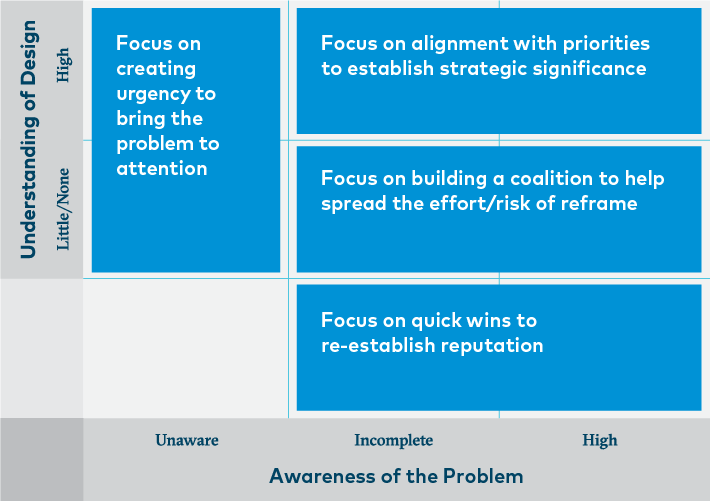CIO, Jim VanderMey, and Design Director, Brian Hauch, discuss a common issue with innovation teams: scaling digital innovations across your organization.
You may have had an innovative idea. You followed all the right processes and through a lot of hard work and a little luck, you found that it’s feasible, viable AND desirable to your customers. But now comes the hard part: scaling that new idea or product throughout your organization.
Brian & Jim share four tips for change agents to make their ideas spread:
- Create Urgency to Drive Attention
- Storytelling: Moving from My Story or Our Story
- Create a Coalition of the Willing
- Demonstrate Progress
Listen in to hear these explained in detail and help your next digital innovation scale.
Enjoy!

This podcast content was created prior to our rebrand and may contain references to our previous name (OST) and brand elements. Although our brand has changed, the information shared continues to be relevant and valuable.
Episode Transcript
Andrew Powell: Hey, everybody on this episode of the podcast, we’re talking to Brian Hauch, OSTs design director, and Jim VanderMey, our chief innovation officer about how you scale proofs of concept across your organization. Are you looking for some tools to add to your toolbox? Have a listen. Enjoy.
Brian Hauch: Today, we’re going to talk a bit about change agents within organizations and as consultants, we’ve seen a lot of organizations go through change and digital transformation, and we have observed over the years various tools that may help change agents get traction with their ideas if they don’t have executive sponsorship.
Jim VanderMey: This is actually a really depressing idea for me because I so often see organizations default to a certain kind of behavior. And when Brian and I were talking about this last week in preparation. I was reflecting on the fact that when I was at an early stage of my career in the eighties that I went to a seminar and they said, you have to have top management support for—at the time—of MRP implementation. And then I went to a seminar on another topic around the use of CAD applications in manufacturing, and they talked about having to have senior management support. And then in the early nineties, when I was employed at Priority Health, I went to a health care event and they talked about you have to have top management support and it felt like, okay, everything is easier when you have executive support in an organization. Well, duh and so many of the themes of change management in an organization simply is around getting people in senior positions of leadership to think the right way so that they’ll do the things that the organization needs to do. And that’s a hard thing for a lot of people to figure out.
View Full Transcript
Andrew Powell: Hey, everybody on this episode of the podcast, we’re talking to Brian Hauch, OSTs design director, and Jim VanderMey, our chief innovation officer about how you scale proofs of concept across your organization. Are you looking for some tools to add to your toolbox? Have a listen. Enjoy.
Brian Hauch: Today, we’re going to talk a bit about change agents within organizations and as consultants, we’ve seen a lot of organizations go through change and digital transformation, and we have observed over the years various tools that may help change agents get traction with their ideas if they don’t have executive sponsorship.
Jim VanderMey: This is actually a really depressing idea for me because I so often see organizations default to a certain kind of behavior. And when Brian and I were talking about this last week in preparation. I was reflecting on the fact that when I was at an early stage of my career in the eighties that I went to a seminar and they said, you have to have top management support for—at the time—of MRP implementation. And then I went to a seminar on another topic around the use of CAD applications in manufacturing, and they talked about having to have senior management support. And then in the early nineties, when I was employed at Priority Health, I went to a health care event and they talked about you have to have top management support and it felt like, okay, everything is easier when you have executive support in an organization. Well, duh and so many of the themes of change management in an organization simply is around getting people in senior positions of leadership to think the right way so that they’ll do the things that the organization needs to do. And that’s a hard thing for a lot of people to figure out.
Brian Hauch: It’s very tough. It’s sometimes read articles about managing up. I’m not quite sure what that means exactly.
Jim VanderMey: How to influence when you don’t have influence power.
Brian Hauch: Yeah, exactly. And so that’s what we’re talking about today and so it’s really interesting. Where do you see ideas coming into an organization from if they don’t come in from the leadership?
Jim VanderMey: Well, I think that it could come from any of the competencies in the organization. It could be product development, it could be manufacturing, it could be in the marketing product research, it could be from IT. And so the orientation to the new could be at any level within an organization. And it could also come from consultants and we as consultants, perhaps are in a difficult place because we have no authority in the organization outside of what they invest us with.
Brian Hauch: So all those various teams within organizations work very efficiently by themselves, right. And they have like value systems and as you’re going through those. Listing those, I was thinking, man, to get IT and marketing to speak to each other and to work together or product development or—
Jim VanderMey: Yeah, so they do, they have very different values and they’ve built decades of competencies around a certain set of values which may not lead them to collaborate very well. I was in a discussion with a CIO of a local company and he was complaining about the marketing team saying words like those pesky people in marketing. Like they’re always asking for things and because they weren’t his traditional constituency, he was actually complaining about the new partnerships in the organization.
Brian Hauch: Which if an organization ever wants to see an idea grow, you have to work across teams.
Jim VanderMey: You have to work together
Brian Hauch: You have to work together.
Jim VanderMey: And how that happens is I think where the sausage is made. It’s a little ugly.
Brian Hauch: Yeah. Have you ever seen it happen?
Jim VanderMey: I have seen it happen. I’ve seen it fail miserably. So where do you want to start?
Brian Hauch: Well, you know, thinking about having all these teams work together and this idea of bringing a new idea to an organization really requires awareness of processes that you need to do to get people to work together and an awareness of the problem. And between those areas you’ve observed a lot of tools that people have used to help drive awareness of what does change look like and drive awareness of what does a problem look like?
Jim VanderMey: Yeah. So driving awareness of a problem, Catherine Ehrenberger, who is the former executive vice president at Amway had said to us when we were developing the atmosphere sky air filtration unit as their first IoT connected product at Amway, that they had a burning platform. And if you think about the traditional oil rig picture of the burning platform, that’s an emergency and urgency you’d have to pay attention to. And she said that if we’re going to be in the durable space, we have to have an IoT connected product because our competitors are bringing these to market. And this has become table stakes. So she described it and created urgency. And that then created a rallying point for the organization to do something that was going to be hard and to do something that broke the normal behaviors and organizational silos to collaborate in a new and different way because it was required to address the immediate important need.
Brian Hauch: The idea of a burning platform is interesting in that you have to create urgency. You have to make it immediate and visceral. And you know, that, I think a lot of times maybe companies get focused on the thing and not sort of the urgency behind moving forward. Like you need to overcome the inertia.
Jim VanderMey: Yeah. And it’s oftentimes portrayed in very black and white terms. This is a take the hill or die moment. And we’ll say that you’re not only building a digital product, but you’re building a digital competency in those moments. So you have to use the sense of what we’re trying to do to change, not just what you’re building, but also the organizational behavior at the same time. Otherwise, it’s a wasted opportunity. You’ll get to the end of building the product and you will not have built the competency to do the next thing. And you’ll find yourself unable to support what you’ve built or unable to do the next thing. So you have to build an organizational competency at the same time you’re building the deal, the products to really change the organization.
Brian Hauch: That’s a fascinating idea. The fact that change is more than just the thing you want to build or the digital process that you want to incorporate. You also have to change the organization around it too.
Jim VanderMey: Yes. And that’s the—there’s a useful graphic that you showed me just last week that I think that we should include in the podcast notes, but it talks about how you—what are those tools? Because in the path to organizational leadership, feeling the need to change the organization, many times the ideas are coming from middle management project teams. How do you move upward then? And if you don’t have a Catherine as an EVP level saying, this is the brain platform that we have to address. So, oftentimes starts off, and this is why we use the term the POC. It oftentimes is the creation of a small case pilot or POC, and to prove that something is possible, fire up the imagination, but how many things have we seen die at the POC phase?
Brian Hauch: Right.
Jim VanderMey: We’ve both have built a number of projects with customers that get through the POC and everyone high-fives each other and says, look what we built. And then what happens?
Brian Hauch: Right, and it’s caught in that team and it needs to somehow be translated across the organization. Also, I’ve also seen people fall in love with their POC and it’s useful to have like multiple POC is going on too, right. So you can like pick and choose what seems to be working and resonating. And it’s not about one per se.
Jim VanderMey: Yeah. We did a series a couple of years ago on moving from the science fair project to business value because a lot of engineering teams and technical teams do get enamored with building out as a science fair project it almost becomes the technical achievement becomes an end in itself. And I see this in a lot of innovation teams where they think that coming up with the idea is an end in itself and it doesn’t necessarily translate into broader organizational value.
Brian Hauch: Yeah. That’s really interesting. So we talked a bit about the burning platform and how do you scale that burning platform across teams?
Jim VanderMey: Well, I think there’s a couple of different ways at doing that. First is does the POC or the pilot project aligned to some strategic priority of the organization? So if there is a strategic priority to address a need in the market. So for example, we did a project with a healthcare organization a few years ago, where they realized that in the face of changing healthcare legislation, they had to have a different way of engaging with their populations. And so they had a strategic priority to do that, but they weren’t driving to the detail. And some of the product teams that were working on projects realized that their projects were connected to that strategic value. And they had to then find ways to connect what they were doing to that broader strategic objective and filter that up to say, this is an embodiment of the strategic outcome objective that was being articulated for the organization. Because the strategic objectives weren’t drilling into the level of detail from an execution standpoint. And so it was really up to the individual project teams to figure out what strategic islands they were going to land on. Otherwise, they’d find themselves wandering around in the ocean of innovation with no safe Harbor. Sorry. That was an extended metaphor that just kind of came to me.
Brian Hauch: I like it. Connecting back to the vision that are the strategic objective of the higher-level strategic objective of the organization requires storytelling and the ability to connect with various teams. And we talked a bit earlier about how each team has a different value system and to create stories that really resonate with them about why this is good for you.
Jim VanderMey: So one of the exercises that I think has been really successful in doing that is billing some infographic or a story or a pitch deck, an internal pitch deck. And it’s really not about the asset that you’re creating, but you’re creating a shared consensus around what the story is through the creation of that product, as you iterate. And I think about a video that you and I worked on for an organization that told the story of a problem. And as the team worked through that development of that video, it really helped coalesce. Everyone agreeing that this is the story that we needed to tell the organization.
Brian Hauch: Yeah. Meaning it’s co-created. When people co-create the meaning, it moves through the organization a lot faster.
Jim VanderMey: So relatively, small engagement or a relatively small project can move from a POC to be part of a narrative and a story through the creation of these additional assets or thinking about it a little more broadly, you know?
Brian Hauch: Yeah. So we talked about the burning platform as a tool that people can use to get alignment, to manage up. And then we’ve talked a bit about a vision and a story that gets co-created between teams. Now let’s talk a bit about how do I find people to start help me to create the process or the innovation?
Jim VanderMey: So finding a coalition of the willing as it were. So, but I’m going to say that sometimes we take the path of least resistance. And the path of least resistance may actually be the worst possible path.
Brian Hauch: Really?
Jim VanderMey: Because the path of least resistance is oftentimes going to be a group of collaborators that feel the same way you already feel about the problem space. And so when we get filed that path of least resistance and we create a collaboration of the willing, then at the end of the day, we have a group of people who are thinking the same way. Aligned around the same problem, but still not in a place of influence in the organization. So we have to elevate that discussion in some fashion and they may not have the authority to enact the change. So you still have to find ways to elevate that to an organizational need to change. So, for example in the connected product space or digital marketing space, we consistently see that direct outreach to customers. or consumers in a more meaningful fashion fundamentally threatens the channels, the historic sales channels, the historic sales roles, the historic multilevel marketing patterns or the existing sales channels and organizations the dealer networks.
And if you don’t figure out how to integrate those parties into the process, and have some enablement for them, some benefit for them then these initiatives often get stranded. And so the coalition of the willing may include a lot of people around product and engineering and digital marketing. But if it doesn’t include the people who have responsibility for the dealer or the sales channel, then the path to economic value is short-circuited. So you’ve got to then engage that member of the coalition, the sales channel member of the coalition, and say, what value would you like us to create with you? So that they’re now invited to be part of the definitional framing of what the coalition of the willing is going to build. And they’re now solving a real problem as opposed to a deeply introspective problem or interesting problem to them. So I would suggest that if you have a coalition of the willing of a group of mid-levels to say who’s the plus one we have to add that might not be a natural partner for us, to demonstrate that I can work cross-functionally with these different groups and then bring value to another part of the organization that here to for has not had that value created.
Brian Hauch:It’s fascinating to think about being strategic with who you collaborate with, right. If you’re trying to create and trying to manage up within an organization, trying to create this center of gravity around your idea, you don’t just need warm bodies of people who are on the same page as you, but you need people with different thoughts, different values, different workflows, different processes.
Jim VanderMey:Yeah. So I think that’s a great way to summarize that point.
Brian Hauch: So now we’ve talked about the burning platform, the storytelling back to a vision, you have a team of people to help go forward, and then we get to finally create something, the POC.
Jim VanderMey: Yeah. So in this case, we have to demonstrate something quickly and effectively and build it to generate a sense of belief. And we’re not doing a POC simply as an act activity of creation. What is it that you want to create belief around? And so we categorize the POC in three different areas. One, it’s a proof of value. Is this actually going to be valuable to the market? And that could be a tabletop exercise. It could be creating. It may be the best POC is the creation of paper mock-ups or digital mock-ups or wireframes to then validate with real people. So proof of value. It could be a design prototype that people can interact with as a concrete form of well, this is what we could actually build. Imagine if we could do this. And it creates a rallying point. The third is, I don’t think we could build it. If the question is, I don’t think we could do it then creating the POC is around the proof that I can do something technically from an engineering standpoint, a technical standpoint, a design build that I demonstrate that I have the capability to add value in this space. And that specifically, when you talk about marketing and IT, marketing or people will work out without outside organizations to generate value with consultants or sa on, but then when they bring it back into the institution, they have to now support it. And so just because you weren’t involved in the first phase collaboratively doesn’t mean that you can’t be involved in the second phase. And so the second phase may be when it has to scale across the organization. And so perhaps the POC is proof that I can be a contributor to the next generation of the product where I wasn’t a contributor in the first generation of the product.
Brian Hauch: It’s really interesting. I’m hearing you describe the various POCs. It makes me think of the importance of understanding the strategy behind what you’re building. And it’s not that I am just going to prototype something, but you need to know what you’re building and what you’re not building. Like, am I trying to create belief around our technical ability to do that? Are we trying to create belief around the customer value and knowing that upfront would determine how you prototype?
Jim VanderMey: Absolutely. And so the prototype is what you’re trying to demonstrate something. You’re trying to prove something, you’re trying to build something that would have might be beyond that concrete organization or that concrete thing.
Brian Hauch: I love this set of four tools that you can use to help get alignment behind new ideas if you find yourself to be the change agent in an organization. Are there certain other sort of wildcards that we should watch out for?
Jim VanderMey: Well, I think the phrase that I like to use is the organizational antibodies. And you imagine that change is being introduced to an organization. And all of the white blood cells of the organizational immune system start clustering around this new thing, because it looks different. It obviously is not part of us. And in that moment when the new is being introduced and this is a consistent story across the innovation literature, whether it’s Clay Christiansen or Moonshots talks about this. It was any number of the illustrations that are used is the idea that you have to protect the innovation team and Clay Christiansen uses the term of the walled garden. Rob Siegel at Stanford talks about protecting the wild ducks. Other freight or people will talk about gold badging the team. They have permission to go across organizational silos and not go through traditional workflows, but it’s permission from the top level of the organization. So when we talk about those old mantras of executive sponsorship and executive support and top management support, what that really gave you as someone on an execution team was permission to not quite follow the rules. To take organizational resources and organizational attention and time to do something that was a little bit against the organizational DNA. And when we talk about against the organizational DNA, that’s what the immune system does. It detects that something is not part of the DNA of the host and says, this is DNA I don’t recognize, these are proteins I don’t recognize, I’m going to attack them.
So there’s that gold badge concept that I give permission. There’s the walled garden, where I separate them out and allow them to flourish in a safe space and greenhouse effectively, or it might be in the use of patient capital where we say that we’re not going to force them into the quarterly performance or utilization targets or profitability targets that we hold the rest of the organization to, because this is an area of investment and it’s going to take 2 3, 4 years for this to pay off. And if it’s going to take four years for this to pay off, I have to have patient capital. And so that’s the way of financially protecting the innovation team. So you can only do a certain number of those in an organization at a time otherwise chaos ensues or financial performance suffers. You look at what GE went through, for example, they have made a huge play on IOT and their Predix platform. And they were moving towards a digital engagement and the chairman of GE lost their position. Jeff Immelt lost his position because they, the shareholders, after years of investment, weren’t seeing the return. And so they brought in an operational execution person. They’d downsize some of the organization. They wrote off investments in the space. GE did not achieve results fast enough at scale enough to allow them to innovate as an organization.
Brian Hauch: So maybe they excelled and being ready to innovate, but they didn’t manage the innovation properly.
Jim VanderMey: They were maybe trying to do too much. And so there was too high of a cost, but they had senior management support. They had patient capital. They had organizational coherence state , they had executive roles for digital transformation and they didn’t make it. So there’s a second part is that don’t try to do too much at the same time so that the organization loses belief or your stakeholders lose belief because you’re costing them too much, too fast. So that’s why the POC is valuable. Build belief at the beginning, build a coalition of the willing plus one, align yourself to corporate objectives. Identify where the urgency is there, but then you’ve got to deliver, then you’ve got to deliver and that’s when the innovation team has to actually shape the business enough to drive it into scale.
Brian Hauch: And hearing you describe all that, it just brings me back to the idea that you need a cross-functional team of people that are the right fit to scale something from the start and not just a coalition of the willing who are like-minded because you have to, at some point, if this is successful, you need to have a team of individuals that can take it and apply it within each of the other teams within the organization that need to support it.
Jim VanderMey: Yes.
Brian Hauch: And so, I love talking through these four topics, right? The idea of a burning platform, the idea of storytelling, connecting it back to a corporate vision, getting the right team of people together. And then all the various types of prototyping that you should do to test out an idea, but also awareness of not doing too much. Right. And it almost sounds like you’re trying to aim for the sweet spot. They have all these tensions and forces pulling at you, and you need to be aware if you’re leaning too much one way or the other. And so keep your balance as you’re moving forward.
Jim VanderMey: And that’s really harder. It is. Because if you’re too small, then you’re not material to the organization. And if you’re too big, you create too much risk, but there is that place in the middle where you can generate value for an organization at scale that makes a difference.
Brian Hauch: And so these are tools that we have seen used in various organizations that we worked with. And hopefully, this has been helpful. It’s probably, as you listened to this, I would imagine a couple of these things may stand out to you like, oh, this is a gap. These are areas that we could do better as we try to scale our ideas. But ultimately it’s not a formula. It’s a recipe. And you need to figure out what’s the recipe, right, for your idea and for the culture of your organization.
Jim VanderMey: You know, I just want to say one final thing as we wrap up, Brian, is that I have really appreciated learning from you about this because there were a lot of points that I’ve seen observationally and anecdotally about change management and design thinking and design strategy that I understood intuitively as a practitioner, but one of the things I’ve learned from you is kind of the structure and the theory behind those things. So that I’ve been able to recognize it’s not just intuition and experience, but there’s actually systems of practice and the thinking that underlie this, that support the things that we see working in the field. So, I’ve just learned a lot about the theory behind organizational change from you and the design tools we use for that. So thanks for sharing those things with us.
Brian Hauch: Thank you, Jim.
Jim VanderMey: Thank you, Brian.
Lizzie Williams: OST, changing how the world connects together. For more information, go to ostusa.com




